Asteroid Bennu & the Yarkovsky Effect
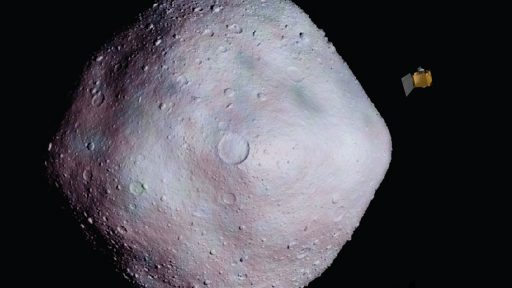
Bennu – a time capsule from 4.5 billion years ago – is a 500-meter wide asteroid in an elliptical orbit around the sun that makes it the most accessible asteroid for a mission from Earth but also one of the most hazardous known objects with multiple close passes to Earth having occurred in the past and more close calls expected in the coming century.
OSIRIS-REx is the first U.S. mission to retrieve a sample from an asteroid, addressing objectives of NASA’s Solar System Exploration Program that has the overall goal of understanding the origin and early formation of the Solar System, examining the origin of water and organic material on Earth, permitting life as we know it today.
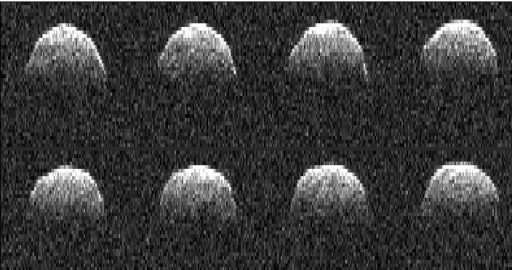
Bennu was discovered in September 1999 by the Lincoln Near-Earth Asteroid Research (LINEAR) project. The asteroid has a mean diameter of approximately 492 meters and completes one lap around the sun every 436.6 Earth days. The orbital geometry between Earth and Bennu creates close passes every six years.
Extensive study of Bennu was conducted with the Arecibo Observatory Planetary Radar and the Goldstone Deep Space Network Station whenever the asteroid was in close proximity to Earth. Ground-based measurements show the asteroid has a rotation period of four hours and 20 minutes; its mass and density are well constrained but will be precisely determined by the OSIRIS-REx mission.
Asteroid Bennu was selected as a target for the OSIRIS-REx mission based on the scientific promise of its exploration as well as operational constraints of the mission’s design. The mission began with ~500,000 asteroids known at the time of the proposal, though only those with close encounters with Earth would be reachable with a reasonable delta-v budget & fuel expense. This narrowed the number to around 8,000.

Further study showed that only 350 asteroids of the 8,000 Near Earth Objects would permit a sample return mission within the calendar constraints of the program. Another important constraint was proximity navigation which requires an asteroid that does not rotate exorbitantly fast which is often the case for asteroids smaller than 200 meters that typically exhibit a tumbling motion instead of a regular rotation. Also, small objects can throw off loose material that would be needed on the surface for sampling.
Of the 350 objects, only 29 had diameters greater than 200m.
The science of the mission aims to sample a carbon-rich asteroid to increase the odds of finding organic materials. Only five of the 29 asteroids showed carbonaceous spectral features.
With the field narrowed to five candidates, the OSIRIS-REx mission team began a detailed observation campaign using ground- and space-based telescopes. Bennu stood out because it was a well-observed object that had been determined to have a benign nature and showed the required spectral signatures to make it interesting to scientists.
Observations from Earth have already yielded a shape model with seven-meter resolution, its orbit and rotation period is well known and its carbonaceous nature was confirmed through spectroscopic and photometric measurements with the Hubble Space Telescope. Environmental conditions, especially surface temperatures that are relevant for the mission, were found to be acceptable through infrared analyses with the Spitzer Space Telescope.
Temperatures on the surface of Bennu fluctuate between -37 and +6 degrees Celsius and thermal forces created by solar heating and photon emission are a predominant influence on the asteroid’s orbit around the sun. Studying this effect will be one of the objectives of the OSIRIS-REx mission.
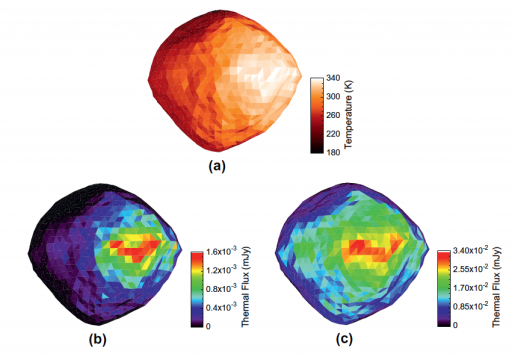
The Yarkovsky Effect is a force acting on a rotating body in space generated by the direction-dependent emission of thermal photons. Photons – despite occupying no volume and possessing no mass – carry momentum and can therefore generate a force on an object. For light bodies such as asteroids up to ten Kilometers in diameter, the Yarkovsky Effect represents the principal force influencing their orbital trajectories around the sun.
Over astronomic time scales, the Yarkovsky Effect can significantly alter an object’s orbit and therefore needs to be factored into trajectory calculations for Earth-intercepting asteroids. However, the quantification of this phenomenon is next to impossible without knowing how the asteroid’s surface properties influence the thermal force generated by photon emission.
This is exactly where OSIRIS-REx will come in – collecting a detailed data set on the composition and topography of Bennu’s surface to learn how an asteroid’s properties influence the Yarkovsky Effect.
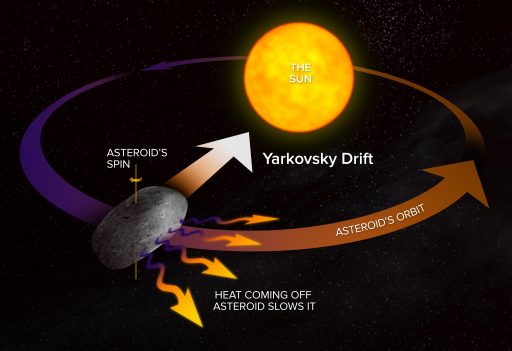
Russian Civil Engineer Ivan Yarkovsky first discussed the effect in a paper around the year 1900, postulating that a rotating object in space would experience a thermal force that – albeit tiny – would play a significant role when looking at the long-term evolution of the orbits of meteoroids and small asteroids.
The primary driver of the Yarkovsky Effect is a delay in the thermal change of an object warmed by radiation which lags behind the changes in incoming radiation: it takes time for a surface to warm up when first illuminated and then takes time to cool down after solar illumination stops.
On a rotating body, the surface on the day side is being warmed by the sun and cools as it rotates to face cold space during the night. Each surface has specific thermal properties creating a lag between the absorption of thermal energy and its release through the emission of thermal photons, meaning the warmest point on a rotating body occurs some time after noon, typically around 2 PM.
This creates a difference between the direction of heat absorption and emission of photons, which – as already stated – carry an impulse. As a result of this difference, the thermal forces of impacting and emitting photons do not cancel out. The net force vector points along the orbital motion of the body – in case of a prograde rotation, the force vector points to the direction of travel of the body, causing it to accelerate, while a retrograde rotator is slowed down and spirals toward the sun.
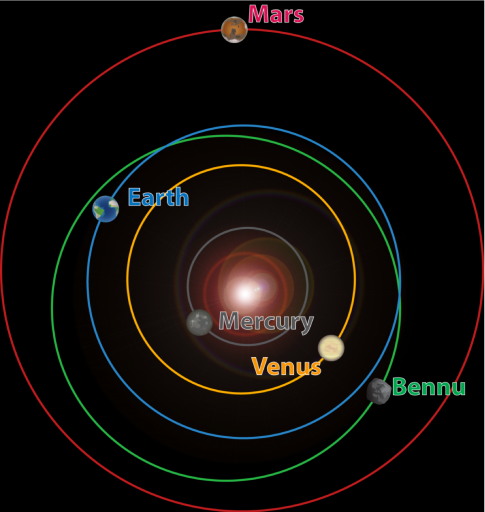
In addition to the diurnal Yarkovsky Effect, there is also a seasonal phenomenon that typically dominates on bodies with very rapid rotation, very small objects and bodies with their own rotation axis tilted close to 90°.
Although the Yarkovsky Effect is relatively small with typical forces not exceeding a fraction of one Newton, it can alter the orbits of asteroids over extended time scales of several million years, transporting them from the asteroid belt into orbits intersecting the inner solar system.
A measurement of the Yarkovsky Effect over the course of 12 years on the 0.6 by 1.4-Kilometer asteroid Golveka showed it drifting 15 Kilometers from its predicted position. This illustrates the importance of taking the Yarkovsky Effect into account for trajectory analysis looking at potential Earth impacts that are still dozens of years away.
To date, predicting the Yarkovsky Effect has been challenging because its magnitude depends on many variables that are hard to determine remotely. Influencing factors include the shape of the object, its orientation, rotation speed and surface properties such as albedo.
OSIRIS-REx will be able to deliver a vast amount of data for detailed modeling of the Yarkovsky Effect on asteroid Bennu, providing valuable data to correlate surface properties with the strength of the phenomenon, helping improve models for the assessment of Earth-impacting asteroids, addressing the need for impact mitigation missions.
For Bennu, scientists initially calculated that there would be eight potential Earth impacts between 2169 and 2199, but this examination was based on the poorly known physical properties of Bennu. With a basic shape model gained through radar observations, the Yarkovsky acceleration could be calculated and the impact probability was reduced to 0.04% for the years of 2175 to 2196. With data from OSIRIS-REx, even more accurate trajectory calculations can be generated, looking further into the future.
